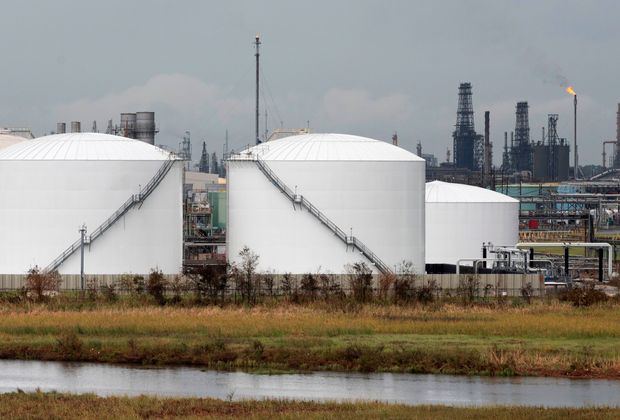
An oil and gas processing plant in Louisiana.
AFP via Getty Images
Like World Wide Wrestling champ Randy Orton, energy stocks came from “outta nowhere” this month to beat the heck out of the rest of the market.
From the day before Pfizer PFE, +2.69% first gave optimism a booster shot with great vaccine news (on Nov. 9) through the close on Wednesday, the SPDR S&P Oil & Gas Exploration & Production exchange-traded fund XOP, +2.61% shot up 29.6%. The S&P 500 index SPX, -0.03% only advanced 2%, and the Dow Jones Industrial Average DJIA, -0.06% rose 4%.
But this move is just getting started. Energy stocks are still a strong buy. This group could be up 60% in a year vs. much more modest gains gain for the indexes above and the Nasdaq Composite COMP, -0.09%.
Sure, after this kind of “outta nowhere” move, energy stocks could sell off near term –- primarily because COVID-19 lockdowns may threaten growth and kill off bullish investor sentiment. But in that scenario, just buy more.
Here are seven reasons why — and 17 of the best stocks and ETFs to consider.
1. Energy names are a cyclical play. Since the March lows, I have been emphasizing cyclical companies in my stock letter. For much of this time I liked them in part because they were hated (a great contrarian play). Other investors like them now, but that’s OK with me.
Cyclical stocks outperform as we move from recession to growth and to more growth. I predict the economy will be phenomenally strong by next summer because of fiscal stimulus as well as progress on the virus.
2. Energy stocks still have big room to move. If oil prices get back to pre-COVID-19 levels along with the economy, energy stocks could move up 60% from here, says Jonathan Waghorn, who manages the Guinness Atkinson Global Energy Fund GAGEX, +0.16% from London. That’s the gain that would take them back to pre-COVID-19 levels – along with oil prices and the economy.
“This rebound is nothing compared to what we lost this year,” says Waghorn.
3. Flights will resume. The COVID-19 recession has been a transportation recession. As vaccines and herd immunity ease worries about the virus, people will fly (and drive) again, bringing back demand for fuel oil, notes Waghorn. That’ll boost energy prices.
U.S. gasoline consumption is at 90% of normal, and jet fuel is at 40%, writes Morgan Stanley energy analyst Benny Wong.
Other key sources of demand like heavy transport and petrochemical production are tightly linked to GDP growth.
4. Energy stocks look cheap. The sector trades at a price-to-book ratio below one, and it has one of the lowest relative valuations to the S&P 500 in the last 70 years, says Waghorn. “We continue to see fairly attractive valuations across the group,” says Morgan Stanley energy analyst Devin McDermott.
5. The crowd has yet to rush in. “Generalists do not yet appear to be coming back to the group even as oil demand and prices are very levered to successful vaccine implementation,” says Goldman Sachs energy analyst Brian Singer.
Lots of people are left to push your stocks higher, if you buy now.
6. Supply won’t necessarily come rushing back. OPEC plus Russia have been well-disciplined about controlling supply to support prices. Waghorn thinks this will continue. These countries will allow prices to rise enough to reap some gains – but not enough to incentivize U.S. frackers to come back online.
U.S. producers are more conservative now, anyway. After outspending cash flow by $50 billion in the past five years, they are planning capital spending of about 70%-80% of cash flow, limiting production growth at 5%-10% a year, says Morgan Stanley’s McDermott.
Otherwise, funds might be tight because lenders are scarce. So are incentives to boost production, since many U.S. producers have hedged away gains from higher oil prices over the next year, says Charif Souki, a co-founder of Tellurian TELL, -0.91%, which invests in natural gas projects. “The U.S. is not coming back to pre-COVID levels. A significant amount of oil is out of the picture,” he says.
7. There are even bigger issues with long-term supply.
Collectively, oil wells naturally lose about 3.5% of production output a year. “So basically, we have to find two Canadas worth of production every year just to keep global supply is flat,” says Larry McDonald of the Bear Traps Report.
During this recession, energy companies significantly cut back on investment in new wells, which take two years or more to bring online. “The market has been clear to producers that if they spend money on long-cycle projects, they will be hammered in the short term,” says McDonald.
The upshot: There will be increasing supply constraints in the coming years due to this underinvestment.
The case for natural gas
North American natural gas NG00, +2.02% prices could move up 60% this winter for several compelling reasons. First, the rise in liquid natural gas exports has drained supply. Next, the amount of “associated natural gas” made by U.S. oil frackers has fallen sharply as they’ve cut production because of lower oil prices.
Third, we may see an unusually cold winter. Thomas Downs at WeatherBELL Analytics predicts population-weighted heating degree days will hit 3,950 in November through March, compared to 3,620 last year, and 3,808 on average over the past 10 years. Heating degree days measure how much average temperatures are below 65 degrees, the temperature below which buildings need to be heated.
Next, natural gas prices have been so low for so long that the number of rigs in production is dangerously low, says Souki at Tellurian. Currently around 70-75 rigs are in production. But Souki estimates we need to have 200, given the challenging dynamics above. “We have never been able to add more than six or seven per month, so it would take two years,” he says.
Finally, under a Joe Biden administration, power plants won’t substitute natural gas with coal as gas prices rise.
The upshot: Souki predicts natural gas will hit $5 per MMBtu compared to $2.60 now.
Stocks to consider
Morgan Stanley’s McDermott favors companies that have the spending and cost discipline to maintain positive free cash flow over a wide range of oil prices. He cites: Devon Energy DVN, +5.12% (recently upgraded); Chevron CVX, +1.66% (strong balance sheet, 6% dividend yield, breaks even at relatively low oil prices); ConocoPhillips COP, +0.91% (high quality assets that can deliver free cash flow and growth); Hess HES, +1.70% (sharply declining oil price break-even over the next five years); and Cimarex Energy XEC, +1.57% (has one of the lowest oil price break-even points).
Goldman Sachs analyst Neil Mehta has a buy rating on Chevron because its earnings are highly leveraged to rising oil prices. Mehta thinks Brent BRN00, +0.33% will hit $60 a barrel, from recent levels of $44, by 2022.
In oil-field services, Morgan Stanley’s Connor Lynagh prefers diversified services companies with strong balance sheets, a global reach, and good free cash flow potential. He singles out Baker Hughes BKR, -2.36%, Schlumberger SLB, +2.35%, Core Laboratories CLB, -1.14% and Tenaris TS, +2.31%.
In natural gas, McDermott likes EQT EQT, +5.83% and Cabot Oil & Gas COG, +2.18%. I’ve recently been suggesting Continental Resources CLR, +4.03% in my stock letter.
For ETFs, consider Energy Select Sector SPDR Fund XLE, +1.46%, iShares Global Energy IXC, +1.13%, VanEck Vectors Oil Services OIH, +1.93%, SPDR S&P Oil & Gas Exploration & Production XOP, +2.61% and Alerian MLP AMLP, +3.40%.
What are the risks?
Potential risks include surprise production supply increases from Iran and Venezuela if the U.S. loosens sanctions, decarbonization efforts, a demise of OPEC cooperation and the chance that U.S. production picks up in response to higher prices. “There is still healthy skepticism regarding managements’ commitment to capital discipline,” says Singer at Goldman Sachs.
Then there is the big one: COVIDovid-19 cases rise so much we see severe lockdowns which really hurt growth. But at least a half dozen vaccines are on the way. So if that happens, it may only be a short-term effect. So buy more energy stocks.
“We look forward to our next buying opportunity,” says McDonald. “The 12-month bull case for oil is more than bright.” He predicts a “supply crisis” in late 2021 could push Brent to $80 to $100 a barrel, from $44 recently. That would create another huge move up, outta nowhere.
Michael Brush is a columnist for MarketWatch. At the time of publication, he owned XOP, TELL and CLR. Brush has suggested XOP, TELL, CLR, DVN, CVX, COP, HES, BKR, SLB, CLB, EQT, COG and CLR in his stock newsletter, Brush Up on Stocks. Follow him on Twitter @mbrushstocks.





